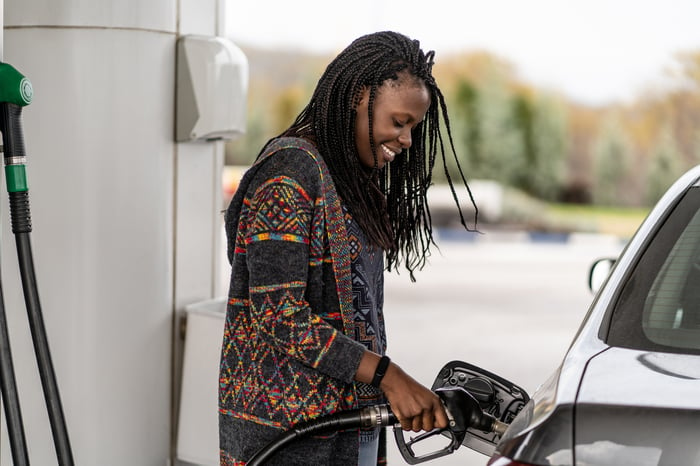There's a big push to switch from carbon fuels to cleaner alternatives, like renewable power. A major piece of the effort is getting more electric vehicles (EVs) on the road. Car makers are getting on board, but even in the best-case scenario the world will need gasoline for decades to come. Sunoco LP (SUN 1.06%), with a huge 7.6% yield, is a way to play the resilience of the gasoline-powered car.
The transition
Carbon dioxide is a greenhouse gas, and one of the larger sources of this gas is the combustion engine that powers most automobiles. With ESG investors fighting hard to reduce the amount of carbon dioxide humans produce, moving away from gasoline cars has been central to the fight. Although news about electric vehicles tends to get a lot of play in the media, in 2020 these vehicles only accounted for 1.7% of U.S. car sales.

Image source: Getty Images.
Given that number, electric cars, as you might suspect, aren't a huge factor in the U.S. market just yet. Now add into the mix the fact that the average gasoline powered car has a useful life of around a dozen years, and you can see why gasoline will continue to play an important role for years. But how important?
In the best-case scenario for EVs, sales will explode to account for more than 70% of vehicle sales by 2040. And, even in that situation, gasoline cars will still make up 56% of the U.S. car fleet, according to a Bloomberg New Energy Fuels forecast. At the other end of the spectrum, the worst-case scenario is that EV sales will lumber along in the low single digits and EVs will be less than 5% of cars on the road in 2040, as estimated by the U.S. Energy Information Administration (EIA). Either way, gasoline will be needed in meaningful quantities. And if you think the outcome is more likely to be toward the low end here, then gasoline-focused master limited partnership Sunoco is worth a closer look.
Moving gas
Sunoco's business is really broken down into two segments, midstream and distribution. The midstream operations focus on moving and storing refined products, notably gasoline. The partnership's footprint of pipelines, terminals, and storage here is basically meant to overlap with its other business, gasoline distribution. That segment trucks gas to convenience stores, independent dealers, and commercial customers in 33 states. It has more than 10,000 customers. It also owns 78 gas stations in New Jersey and Hawaii, but this is a relatively small portion of the business.
Acquisitions are likely to be a key growth platform on both the midstream and distribution sides of the business. Indeed, with another 17 states that it can expand into, Sunoco has ample room to expand. The partnership has made 10 acquisitions since 2014, so this is not a new approach. That said, Sunoco hit a low point in 2018, shortly after it announced plans to refocus around fuel distribution and logistics in April of 2017. It has since been growing adjusted earnings before interest, taxes, depreciation, and amortization (EBITDA). Basically, after a brief transition period, that included jettisoning owned gas stations, it appears to have turned the ship back in the right direction. Basically, the future here is likely to be smoother than the past when it comes to acquisitions and divestitures. It can also grow from within, attracting new customers to its gas distribution operations and expanding its midstream assets via additional capital investment. For example, it currently has $150 million in capital spending plans in 2022 that it believes it can self fund.
SUN Dividend data by YCharts
To be fair, the distribution hasn't grown in a number of years despite the partnership's acquisition efforts. The disbursement has been stuck at $0.8255 per share per quarter since 2016. However, that's actually a testament to Sunoco's commitment to unitholders. Early on the partnership was working to reduce leverage and increase its distribution coverage as it shifted its business model. When the pandemic hit gasoline demand in early 2020, Sunoco LP was ready for the headwind. During that global rough patch, the partnership's distributable cash flow covered the distribution by more than 1.4 times. Through the first nine months of 2021 coverage still exceeded that internal management target, too. Put simply, there's ample room for adversity here.
The long run vs the here and now
Clearly, in the very long term, the gasoline engine car looks like it is heading toward extinction. But it will likely take a long time for that to happen, and income-focused investors can still generate a generous cash stream from Sunoco as it continues to serve the needs of the industry. This is not a low-risk investment, noting that it is controlled by Energy Transfer, which has a history of taking an aggressive approach to its business that might, perhaps rightly, strain the trust of more conservative investors. And owning Sunoco is pretty much the antithesis of a clean energy investment. However, if you are a more aggressive type, and willing to take a contrarian stance, it could still present an interesting income opportunity now that its business transformation is in the past and the business is in a much stronger financial position.



